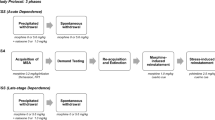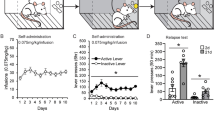Abstract
We examined the effect of morphine pretreatment spacing on intensity of subsequent precipitated withdrawal response to test the hypothesis that withdrawal intensity would be inversely related to pretreatment spacing. Subjects were ten nondependent male volunteers who reported using opioids an average of 2.5 times per week. Three IM morphine injections (each 18 mg/70 kg) were administered during each of four experimental conditions. The experimental conditions involved spacing injections at 12-, 24-, 48- or 72-h intervals. Naloxone (10 mg/70 kg IM) was administered 24 h after the last morphine exposure. A comparison condition was included in which a naloxone challenge was given at 24 h following a single IM morphine pretreatment (18 mg/70 kg). Subject rated measures of symptoms and observer-rated measures of signs indicated that withdrawal intensity was inversely related to the morphine spacing interval and in particular that intensity of withdrawal precipitated after three pretreatments spaced at 12-h intervals was greater than that precipitated after a single morphine pretreatment. Physiological data supported a more intense withdrawal response in the 12-h spacing condition and provided evidence of overshoot on blood pressure and skin temperature measures. These findings are pertinent to the transition between acute and chronic physical dependence; they suggest that there is a temporal window during which repeated opioid administrations result in escalation of physical dependence but that dependence levels after widely spaced multiple exposures may be no greater than after a single exposure.
Similar content being viewed by others
References
Aceto MD, Flora RE, Harris LS (1977) The effects of naloxone and nalorphine during the development of morphine dependence in rhesus monkeys. Pharmacology 15:1–9
Bickel WK, Stitzer ML, Liebson IA, Bigelow GE (1988) Acute physical dependence in man: Effects of naloxone after brief morphine exposure. J Pharmacol Exp Ther 244:126–132
Blackwell JS (1983) Drifting, controlling and overcoming: opiate users who avoid becoming chronically dependent. J Drug Issues 3:219–235
Blasig J, Herz A, Reinhold K, Zieglgansberger S (1973) Development of physical dependence on morphine in respect to time and dosage quantification of the precipitated withdrawal syndrome in rats. Psychopharmacologia. 33:19–38
Brady JV, Lukas SE (eds) (1984) Testing drugs for physical dependence potential and abuse liability. NIDA Research Monograph 52. DHHS Publication No. (ADM) 84-1332. Washington, DC
Cheney DL, Goldstein A (1971) Tolerance to opioid narcotics: time course and reversibility of physical dependence in mice. Nature 232:477–478
Crawford GA, Washington MC, Senay EC (1983) Careers with heroin. Int J Addict 18:701–715
Eisenberg RM (1982) Further studies on the acute dependence produced by morphine in opiate naive rats. Life Sci. 31:1531–1540
Eisenberg RM, Sparber SB (1979) Changes in plasma corticosterone levels as a measure of acute dependence upon levorphanol in rats. J Pharmacol Exp Ther, 21:364–369
Griffiths RR, Bigelow GE, Liebson IA, Kaliszak, JE (1980) Drug preference in humans: double-blind choice comparison of pentobaribital, diazepam, and placebo. J Pharmacol Exp Ther 215:649–661
Heishman SJ, Stitzer ML, Bigelow GE, Liebson IA (1989a) Acute opioid physical dependence in postaddict humans: naloxone dose effects after brief morphine exposure. J Pharmacol Exp Ther 248:127–134
Heishman SJ, Stitzer ML, Bigelow GE, Liebson IA (1989b) Acute opioid physical dependence in humans: effect of varying the morphine-naloxone interval I. J Pharmacol Exp Ther 250:485–491
Heishman SJ, Stitzer ML, Bigelow GE, Leibson IA (1990) Acute opioid physical dependence in humans: effect of repeated naloxone challenge at 6 and 24 h. Pharmacol Biochem Behav 36:393–399
Himmelsbach CK (1941) The morphine abstinence syndrome, its nature and treatment. Ann Int Med 15:829–839
Jacob JJ, Michaud GM (1974) Acute physical dependence in the waking dog after a single low dose of morphine. Psychol Med 4:270–273
Jacob JJC, Barthelemy CD, Tremblay EC, Colombel ML (1974) Potential usefulness of single-dose acute physical dependence on and tolerance to morphine for the evaluation of narcotic antagonists. In: Braude MC, Harris LS, May EL, Smith JP, Villarreal JE, (eds) Advances in biochemical psychopharmacology, vol 8, narcotic antagonists. Raven Press, New York, pp 299–318
Jones, RT (1980) Dependence in non-addict humans after a single dose of morphine. In: Way EL (ed) endogenous and exogenous opiate agonists and antagonists. Pergamon Press, New York, pp 557–560
Jones, RT (1981) Caffeine enhances morphine dependence in humans. In: Takagi H Simon E (eds) Advances in endogenous and exogenous opioids Elsevier, New York, pp 472–474
Kirby KC, Stitzer ML, Heishman SJ (1990) Acute opioid physical dependence in humans: effect of varying the morphine-naloxone interval II. J Pharmacol Exp Ther 255:730–737
Kosersky DS, Harris RA, Harris LS (1974) Naloxone-precipitated jumping activity in mice following the acute administration of morphine. Eur J Pharmacol 26:122–124
Martin, WR Eades, CG (1964) A comparison between acute and chronic physical dependence in the chronic spinal clog. J Pharmacol Exp Ther 146:385–394
Martin WR, Sloan JW (1977) Neuropharmacology and neurochemistry of subjective effects, analgesia, tolerance, and dependence produced by narcotic analgesics. In: Martin WR (ed) Handbook of experimental pharmacology, vol 45, drug addiction I, Springer, Berlin, Heidelberg, New York pp 43–158
Martin WR, Gilbert PE, Jasinski DR, Martin CD (1991) An analysis of naltrexone precipitated abstinence in morphine-dependent chronic spinal dogs. J Pharmacol Exp Ther 240:565–570
Miksic S, Sherman G, Lal H (1981) Discriminative response control by naloxone in morphine pretreated rats. Psychopharmacology 72:179–184
Nakaki T, Saito M, Nakadate T, Tokunaga Y, Kato R (1981) Acute physical dependence induced by continuous intravenous infusion of morphine or meperidine in the rat. Psychopharmacology 73:15–218
Smits SE (1975) Quantitation of physical dependence in mice by naloxone-precipitated jumping after a single dose of morphine. Res Commun Chem Pathol Pharmacol 10:651–661
Way EL, Loh HH, Shen FH (1969) Simultaneous quantitative assessment of morphine tolerance and physical dependence. J Pharmacol Exp Ther 167:1–8
Wikler A (1980) Opioid dependence: mechanisms and treatment. Plenum Press, New York
Wikler A, Carter RL (1953) Effects of single doses of n-allylnormorphine on hindlimb reflexes of chronic spinal clogs during cycles of morphine addiction. J Pharmacol Exp Ther 109:92–101
Wikler A, Havelock FF, Isbell H (1953) N-allynormorphine: effects of single doses and precipitation of acute “abstinence syndromes” during addiction to morphine, methadone, or heroin in man (post-addicts). J Pharmacol Exp Ther 109:8–20
Wiley JN, Downs DA (1979) Naloxone-precipitated jumping in mice pretreated with acute injections of opioids. Life Sci 25:797–802
Wright C, Bigelow GE, Stitzer ML Liebson IA (1991) Acute physical dependence in humans: Repeated naloxone-precipitated withdrawal after a single dose of methadone. Drug Alcohol Depend 27:139–148
Yano I, Nishino H, Murano T (1979) Antagonism by naloxone of tolerance and dependence in mice given a single dose of morphine. Jpn J Pharmacol 29:357–366
Yano I, Takemori AE (1977) Inhibition by naloxone of tolerance and dependence in mice treated acutely and chronically with morphine. Res Commun Chem Path Pharmacol 16:721–734
Zinberg NE, Jacobson RC (1976) The natural history of “chipping”. Am J Psychiatry 133:37–40
Author information
Authors and Affiliations
Additional information
This research was supported by USPHS Grant DA-04011 and Research Training Grant T32 DA-07209 from the National Institute on Drug Abuse
Rights and permissions
About this article
Cite this article
Kirby, K.C., Stitzer, M.L. Opioid physical dependence development in humans: effect of time between agonist pretreatments. Psychopharmacology 112, 511–517 (1993). https://doi.org/10.1007/BF02244902
Received:
Revised:
Issue Date:
DOI: https://doi.org/10.1007/BF02244902




